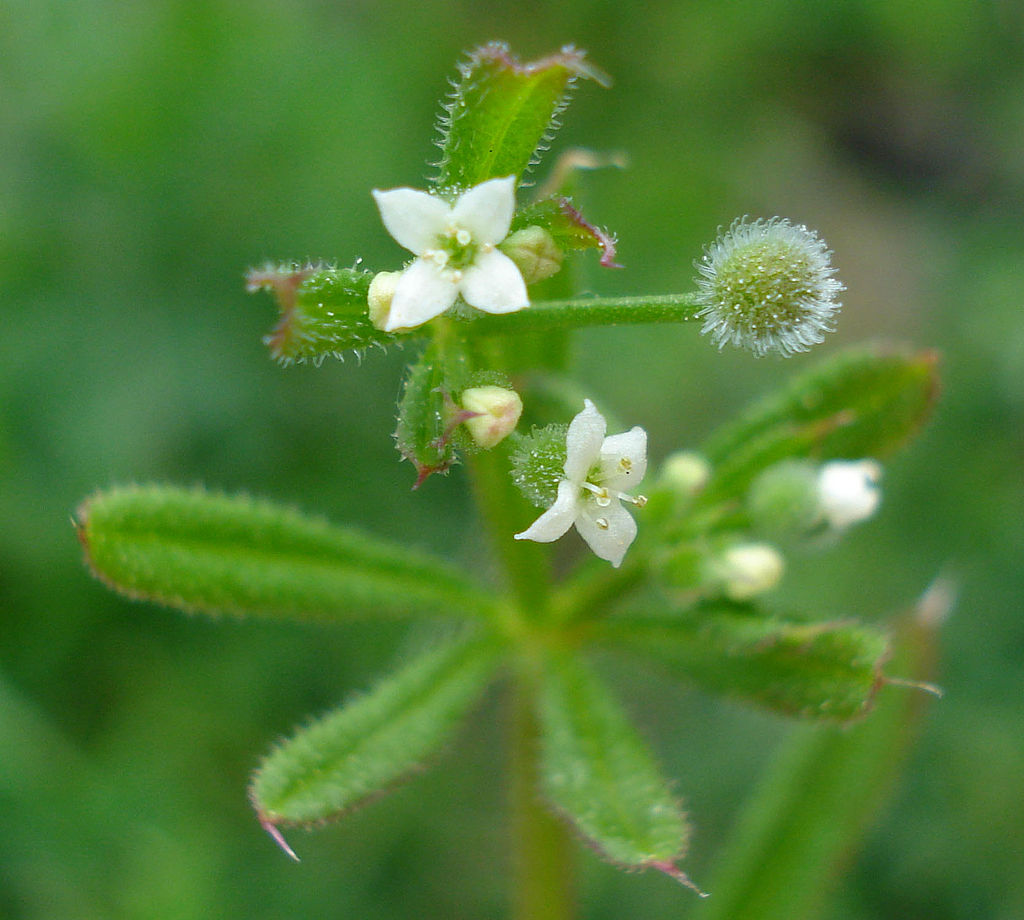CLEAVERS
Botanical Names: Galium aparine, G. asprellum, G. boreale, G. trifidum, G. triflorum, G. verum, G. spp.
Common Names: Cleaver, cleavers, bedstraw, lady’s bedstraw, clivers, goose grass, catchweed, sticky willy, hedge-burs, grip-grass, mutton chops, robin-run-in-the-grass, maid’s hair, everlasting friendship, aparine, gaillet petit muguet (French), klebenkraut (German), cappello dei tignosi (Italian), cuaja leche (Spanish), coban suzegi (Turkish) (1)
Family Name: Rubiaceae
DESCRIPTION
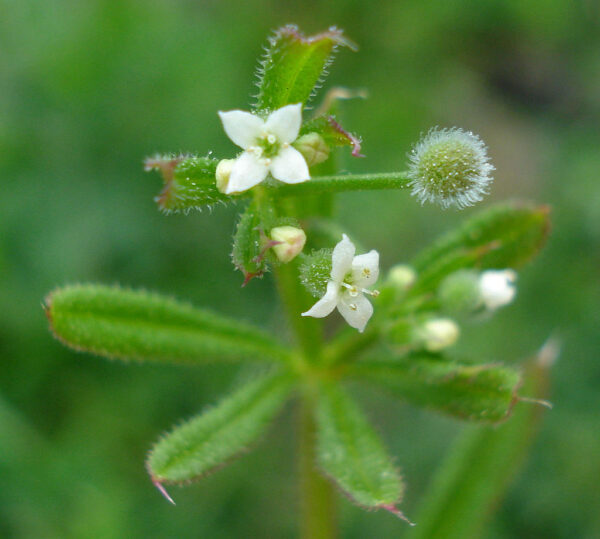
Parts Used: The foliage or above-ground parts.
Botanical Description: Cleavers is widely distributed in the United States, although multiple Galium species are native to Europe, Asia, and North Africa. It grows in moist, shady, wooded areas next to streams or riverbanks, and thrives in rich, moist, alkaline soils. The origin of cleavers is debated; most sources claim that Galium is native to North America.
More than 45 species and many subspecies of Galium grow in California. (2) Galium species range from annuals like G. aparine, to perennials like G. boreale. Their growth habits range from erect and shrubby, to prostrate or climbing. (2) The plants are glabrous or hairy, and they are often rough to the touch. Many Galium species are known for feeling like a cat’s tongue when grasped. When young, the stems of Galium species are square. The leaves grow in distinctive whorls of four or more, often with leaf-like stipules growing out of the same nodes as the leaves. Some species are dioecious. (2) The inflorescence is a panicle or simply axillary clusters of two or more flowers. (2) The rotate to bell shaped, asepalous, greenish flowers can be bisexual or unisexual with sterile stamens or pistils. (2) There are generally four lobes in the fused corolla, two lobes in the ovary, and two styles fused at their bases. (2) Depending on the species, the fruit bears two nutlets, or one berry. (2)
Galium aparine, the species most commonly used in commerce, is a bisexual annual plant that tends to climb or lay prostrate, though it is sometimes low and erect. (2) The small hooked hairs on the plant adhere to surrounding objects and plants, allowing it to climb. (2) The stem grows 30 to 90 cm long, and is brittle and weak.2 The narrow, oblanceolate leaves grow in whorls of six to eight leaves (10-30 mm long). (2) The leaves lower on the stem will be petioled; those higher on the stem are sessile. (2) The flower has a whitish, rotate corolla and bears nutlets. (2)
The Name: The genus name Galium derives from the Greek gala (“milk”) because the juice of G. verum was used to curdle milk. (3) In Greek, the species name aparine means “bedstraw,” as the foliage was used to stuff mattresses. A mixture of bracken and bedstraw was believed to have lined the bed of the Virgin and the manger of baby Jesus; thus, Galium verum acquired the name “our lady’s bedstraw.” (4) The epithet boreale means “of the north.”
The common name cleavers (clivers) derives from the Anglo-Saxon clife and Dutch kleef-kruid (“to cleave or cling”). Clivers (“claws”) derives from Old English. It acquired the common name goose-grass because geese consumed it.
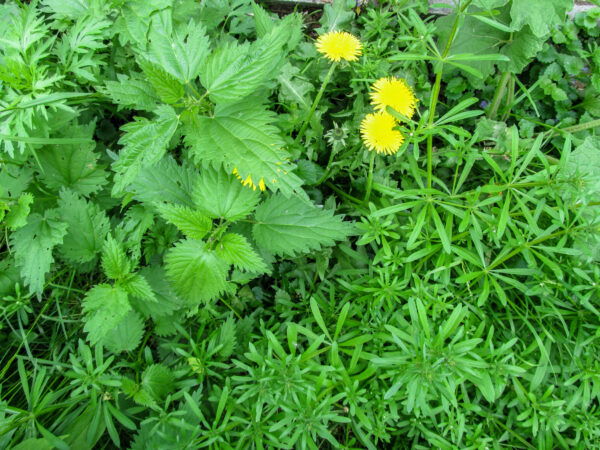
Historical Uses: The tender young greens were consumed as a pot herb. The herb was used traditionally as an antiscorbutic. The Scandinavians used masses of the leaves and stems to filter milk. (4) The roasted seeds of some species are reported to have a coffee-like flavor. Consuming a cold infusion of the herb two to three times daily for two to three months and topical use of the tea were said to remove freckles, according to Old English folklore. (1)
Cowichans rubbed cleavers into their hands to remove pitch, and used the dried herb to start fires. (4) Ditidahts applied a cleavers hair rinse for lustrous, thick hair. (4) The Cree used the dried herb of Galium triflorum as a perfume. (5)
Constituents: Cleavers contains flavonoids (quercetin and rutin), iridoid glycosides (asperuloside, 10-deacetylasperulosidic acid, asperulosidic acid, monotropein, and aucubin), monotropein, coumarins, a bitter principle, tannins, phenolic acid (caffeic acid derivatives), vitamin C, citric acid and a trace of nicotinic acid.5-7
Nutritional Properties: Cleavers contains vitamin C and citric acid. It was used traditionally as an antiscorbutic herb. (5-7)
Medicinal Properties: Diuretic, alterative, anti-inflammatory, eliminative, lymphatic, nutritive, and vulnerary.
Energetic Properties: Cool, sweet, salty, and bland.
MEDICINAL USES
![]()
![]()
![]()
Enhances Diuresis
![]()
Cleavers is a valuable diuretic that reduces edema-related swelling in the hands, feet, eyelids, face, or breasts. Long-term consumption aids in treating dysuria, bladder irritability, benign prostatic hypertrophy, and nephritis.9 It can be used as a short-term diuretic to treat urinary tract infections. Note: Additional anti-infective agents are also necessary to treat bacteria. Cleavers is included in weight loss formulas to reduce water-related weight gain. The flavonoids are attributed to the diuretic effect. (7)
Improves Elimination of Uric Acid
Cleavers supports the kidneys’ elimination of metabolic byproducts such as uric acid.8 Long-term consumption of cleavers tea aids in treating conditions such as gout, arthritis, and kidney stones that result from uric acid buildup. (6-8) Also, skin conditions, such as eczema, psoriasis, and boils can be aggravated when the kidneys are taxed by excess uric acid. (8,10) Prepare a diuretic tea with cleavers, chickweed (Stellaria), couch grass (Triticum), nettle leaf (Urtica), horsetail (Equisetum), and/or dandelion (Taraxacum) to enhance uric acid excretion. Consume 8-12 ounces, one to two times daily.
Gentle Lymphatic
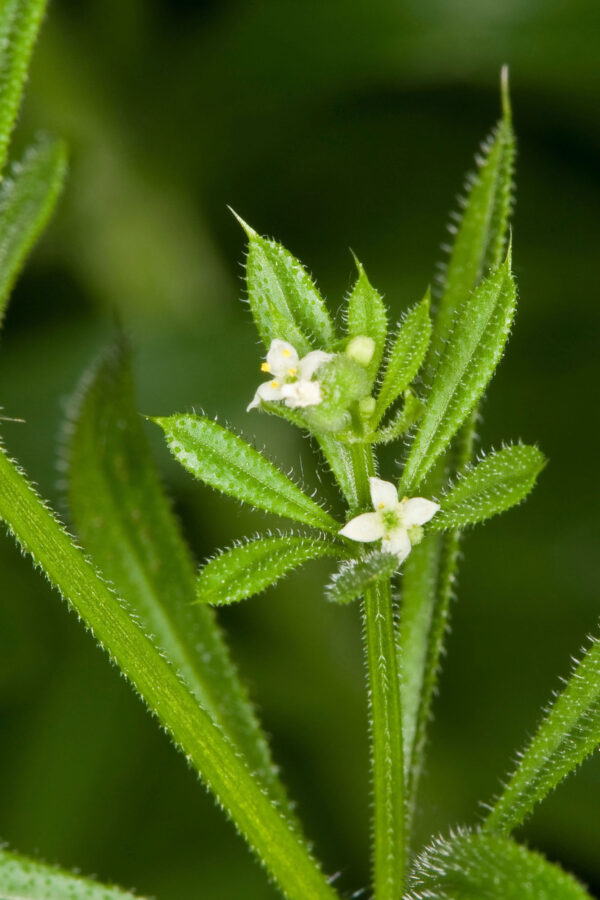
Due to its diuretic and lymphatic properties, cleavers is considered a depurative (blood cleanser) and alterative. It is a cooling lymphatic that reduces swelling and tenderness in the lymph nodes. (10) Cleavers is not a direct antimicrobial, although it can be combined with other disinfectants to treat swollen lymph nodes caused by mononucleosis, cold, flu, or herpes. When lymphatic swelling results from an infection, combine cleavers with extracts of echinacea (Echinacea), red root (Ceanothus), and yerba mansa (Anemopsis). Combine cleavers with lymphatic herbs such as red root (Ceanothus), echinacea (Echinacea), figwort (Scrophularia), burdock root (Arctium), violet (Viola), and/or calendula (Calendula) for non-infected, hard, swollen lymph nodes.
Eases Breast Tenderness
Internal and external use of cleavers aids in treating tender breasts, fibrocystic breasts, and benign breast lumps. Cleavers is an adjunct that supports individuals receiving conventional treatment for breast cancer and for breast cancer survivors. Apply the salve or poultices topically, one to two times daily. The following salve recipe has been a very effective topical application for breast tenderness and lymph swelling. This lymphatic salve contains numerous lymphatic herbs such as figwort (Scrophularia), chickweed (Stellaria), violet (Viola), calendula (Calendula), and cleavers.
Lymphatic Salve Recipe
Gather the fresh herbs, wilt for one to three days, and cook in a base oil blend containing 2/3 extra virgin olive oil and 1/3 castor oil using the double boiler oil preparation method. Strain the oil and prepare as a salve. Add lymphatic essential oils such as bay laurel (Laurus nobilis) to improve the effectiveness of the salve. The salve may be applied one to two times daily to swollen, tender or lumpy breasts, and to swollen lymph in the throat, armpit, or groin.
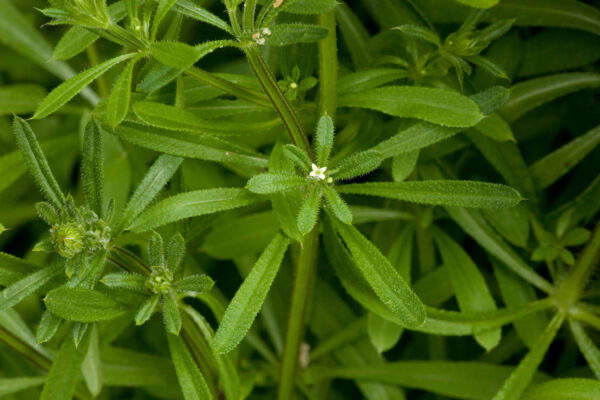
Topical Use
Apply the fomentation, poultice, salve, or juice of fresh cleavers as a vulnerary and anti-inflammatory. (7,8) Freeze the succus in ice cube trays and apply topically to abrasions, burns, cuts, bites, stings, rashes, dermatitis, eczema, and poison oak to reduce inflammation and itching, and prevent scarring. (7,8) The anti-inflammatory effects are due to the asperuloside. (6)
CONTRAINDICATIONS
There are no known contraindications. However, when an individual is suffering from chronic edema, it is important to consult with a medical practitioner, as severe edema can be associated with heart, kidney, or thyroid conditions. (7)
METHODS OF PREPARATION AND DOSAGE
Tincture: Fresh foliage [1:2-1:3, 70-95% alcohol]; consume 30-90 drops, up to four times daily.
Succus: Fresh cleavers can be prepared as a succus by juicing the herb, and adding 10-20% alcohol to the total juice volume to preserve it. The low percentage of alcohol can prevent spoilage, but the succus will last longer if it is refrigerated.
Acetum Extract: Fresh foliage [1:2, apple cider vinegar]; consume 30-90 drops, up to four times daily.
Tea: Prepare a hot or cold infusion of the herb; consume 8-12 ounces, up to four times daily.
Topical Use: Wilt the leaves one to three days and prepare with the oil using the double boiler method. Apply the oil or salve topically, one to three times daily.
Culinary Use: The fresh leaves or leaf tips can be steamed or added to stews. They are best cooked, because the small hair-like projections of the fresh herb can irritate the throat. The fresh herb can be juiced for consumption, or poured into ice cube trays and frozen for internal or topical use. After the ice cubes are formed, freeze them in a sealed container or zip-lock bag.
Works Cited
- Grieve M. A Modern Herbal. Great Britain: Jonathan Cape Ltd.; 1931: 206.
- Hickman JC (ed.). The Jepson Manual: Higher Plants of California. Berkeley, CA: University of California Press; 1996: 978-986.
- Munz PA. A Flora of Southern California. Berkeley, CA: University of California Press; 1974: 765.
- Pojar J, MacKinnon A. Plants of the Pacific Northwest Coast. Vancouver, BC: Lone Pine Publishing; 1994: 330.
- Willard T. Edible and Medicinal Plants of the Rocky Mountains and Neighboring Territories. Calgary, AB: Wild Rose College of Natural Healing; 1992: 189.
- Foster S. Herbal Renaissance. Layton, UT: Peregrine Smith Books; 1993: 199-200.
- Skenderi G. Herbal Vade Mecum. Rutherford, NJ: Herbacy Press; 2003: 38.
- Moore M. Lecture presented at Southwest School for Botanical Medicines residency program. Albuquerque, NM; 1994.
- Ellingwood F. American Materia Medica, Therapeutics, and
- Pharmacognosy. Rev. ed. Albuquerque, NM: Southwest School for Botanical Medicine; 1994:53.
- Mills S, Bone K. Principles and Practice of Phytotherapy. London, UK: Harcourt Publishers Limited; 2000:148.
© Copyright – Christa Sinadinos (Excerpts from “The Essential Guide to Western Botanical Medicine”)

